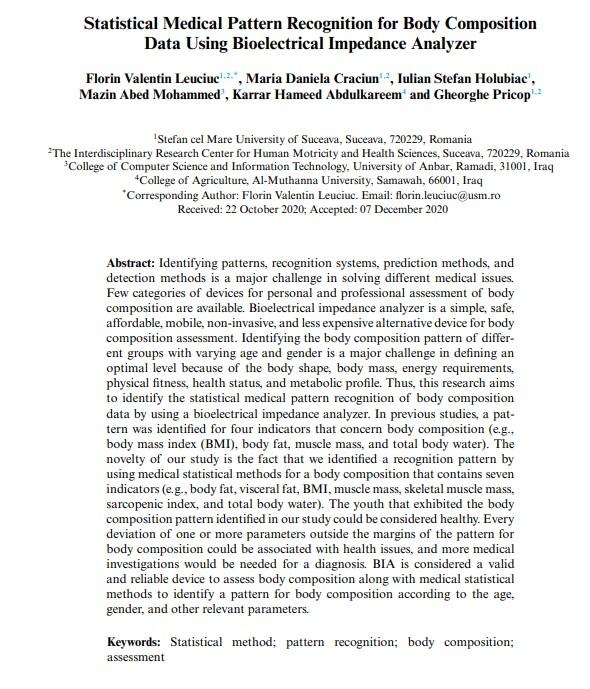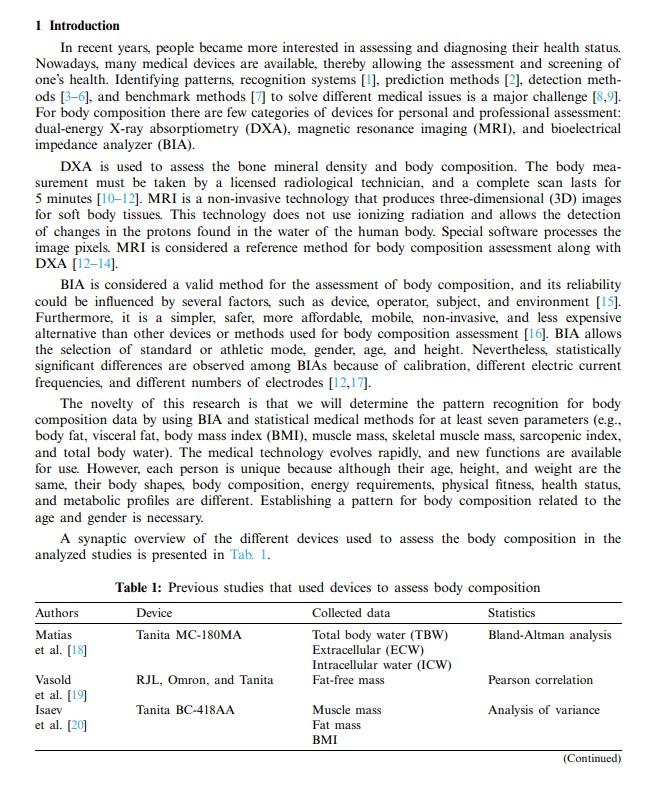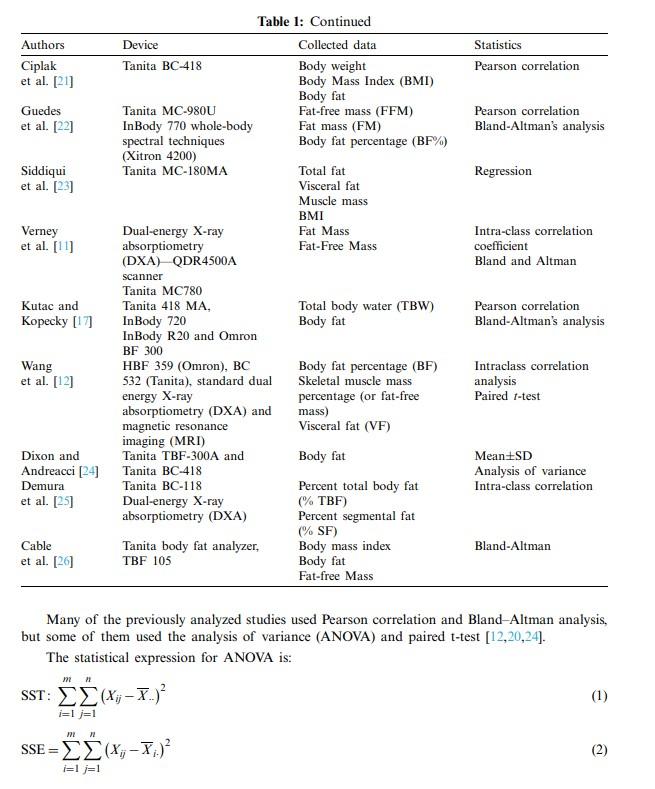Answered step by step
Verified Expert Solution
Question
1 Approved Answer
I need the summary of the methodology and your idea about this paper. Please mention the figure number as well. Statistical Medical Pattern Recognition for














I need the summary of the methodology and your idea about this paper. Please mention the figure number as well.
Statistical Medical Pattern Recognition for Body Composition Data Using Bioelectrical Impedance Analyzer Florin Valentin Leuciuc ,2,", Maria Daniela Craciun 1,2, Iulian Stefan Holubiac 1, Mazin Abed Mohammed", Karrar Hameed Abdulkareem Mand Gheorghe Pricop 1,2 1 Stefan cel Mare University of Suceava, Suceava, 720229, Romania Interdisciplinary Research Center for Human Motricity and Health Sciences, Suceava, 720229, Rom: College of Computer Science and Information Technology, University of Anbar, Ramadi, 31001, Irac 4 College of Agriculture, Al-Muthanna University, Samawah, 66001, Iraq 'Corresponding Author: Florin Valentin Leuciuc. Email: florin.leuciuc@usm.ro Received: 22 October 2020; Accepted: 07 December 2020 Abstract: Identifying patterns, recognition systems, prediction methods, and detection methods is a major challenge in solving different medical issues. Few categories of devices for personal and professional assessment of body composition are available. Bioelectrical impedance analyzer is a simple, safe, affordable, mobile, non-invasive, and less expensive alternative device for body composition assessment. Identifying the body composition pattern of different groups with varying age and gender is a major challenge in defining an optimal level because of the body shape, body mass, energy requirements, physical fitness, health status, and metabolic profile. Thus, this research aims to identify the statistical medical pattern recognition of body composition data by using a bioelectrical impedance analyzer. In previous studies, a pattern was identified for four indicators that concern body composition (e.g., body mass index (BMI), body fat, muscle mass, and total body water). The novelty of our study is the fact that we identified a recognition pattern by using medical statistical methods for a body composition that contains seven indicators (e.g., body fat, visceral fat, BMI, muscle mass, skeletal muscle mass, sarcopenic index, and total body water). The youth that exhibited the body composition pattern identified in our study could be considered healthy. Every deviation of one or more parameters outside the margins of the pattern for body composition could be associated with health issues, and more medical investigations would be needed for a diagnosis. BIA is considered a valid and reliable device to assess body composition along with medical statistical methods to identify a pattern for body composition according to the age, gender, and other relevant parameters. Keywords: Statistical method; pattern recognition; body composition; assessment In recent years, people became more interested in assessing and diagnosing their health status. Nowadays, many medical devices are available, thereby allowing the assessment and screening of one's health. Identifying patterns, recognition systems [1], prediction methods [2], detection methods [3-6], and benchmark methods [7] to solve different medical issues is a major challenge [8,9]. For body composition there are few categories of devices for personal and professional assessment: dual-energy X-ray absorptiometry (DXA), magnetic resonance imaging (MRI), and bioelectrical impedance analyzer (BIA). DXA is used to assess the bone mineral density and body composition. The body measurement must be taken by a licensed radiological technician, and a complete scan lasts for 5 minutes [10-12]. MRI is a non-invasive technology that produces three-dimensional (3D) images for soft body tissues. This technology does not use ionizing radiation and allows the detection of changes in the protons found in the water of the human body. Special software processes the image pixels. MRI is considered a reference method for body composition assessment along with DXA [12-14]. BIA is considered a valid method for the assessment of body composition, and its reliability could be influenced by several factors, such as device, operator, subject, and environment [15]. Furthermore, it is a simpler, safer, more affordable, mobile, non-invasive, and less expensive alternative than other devices or methods used for body composition assessment [16]. BIA allows the selection of standard or athletic mode, gender, age, and height. Nevertheless, statistically significant differences are observed among BIAs because of calibration, different electric current frequencies, and different numbers of electrodes [12,17. The novelty of this research is that we will determine the pattern recognition for body composition data by using BIA and statistical medical methods for at least seven parameters (e.g., body fat, visceral fat, body mass index (BMI), muscle mass, skeletal muscle mass, sarcopenic index, and total body water). The medical technology evolves rapidly, and new functions are available for use. However, each person is unique because although their age, height, and weight are the same, their body shapes, body composition, energy requirements, physical fitness, health status, and metabolic profiles are different. Establishing a pattern for body composition related to the age and gender is necessary. A synaptic overview of the different devices used to assess the body composition in the analyzed studies is presented in Tab. 1. Many of the previously analyzed studies used Pearson correlation and Bland-Altman analysis, but some of them used the analysis of variance (ANOVA) and paired t-test [12,20,24]. The statistical expression for ANOVA is: SST:i=1mj=1n(XijX.)2SSE=i=1mj=1n(XijXi)2 SS(Tr)=ni=1m(XiX)2 i=1mj=1n(XijX..)2=i=1mj=1n(XijXi)2+ni=1m(XiX..)2 SST-Sum of Squares - Total SSE-Sum of Squares - Error SS(Tr)-Sum of Squares - Treatment/case m-Number of samples n-Total size of all the samples. Finally, with previous data, determining the value of F is possible: F=SSE/(m(n1)SS(Tr)/(m1)MSEMS(Tr)F[m1,m(n1)]. MS-Mean square. A synthetic view for all this operation to determine F by using analysis of variance (ANOVA) is shown in Tab. 2 . Table 2: Summary table of one-way ANOVA The statistical significance of at least pStep by Step Solution
There are 3 Steps involved in it
Step: 1

Get Instant Access to Expert-Tailored Solutions
See step-by-step solutions with expert insights and AI powered tools for academic success
Step: 2

Step: 3

Ace Your Homework with AI
Get the answers you need in no time with our AI-driven, step-by-step assistance
Get Started


